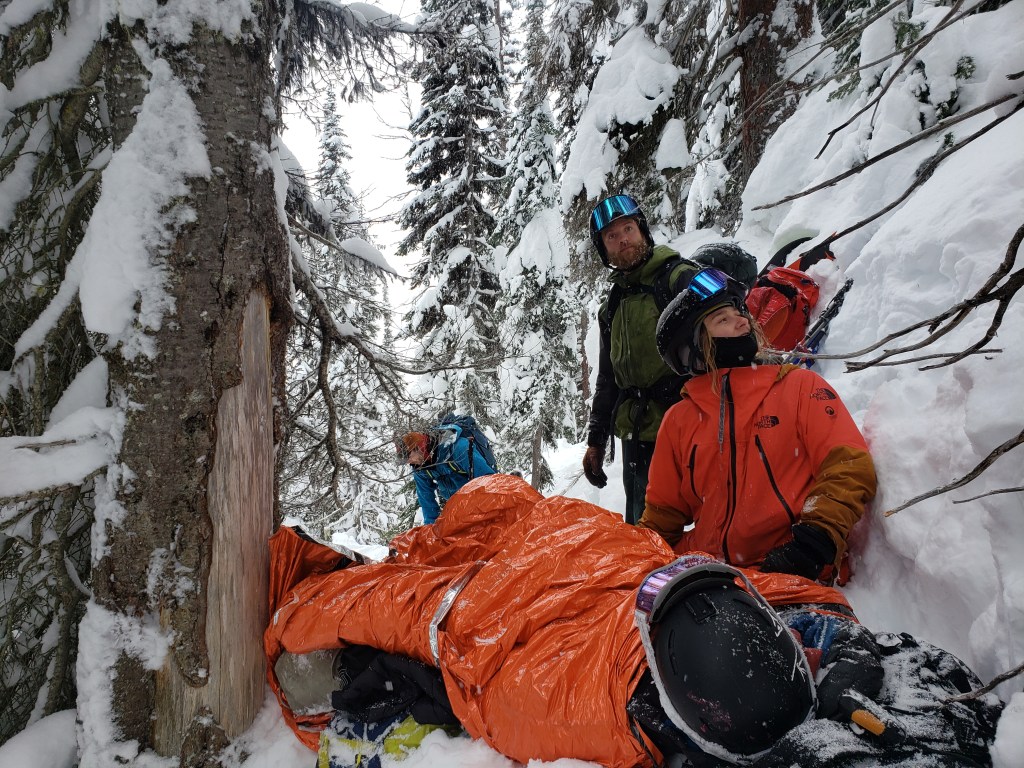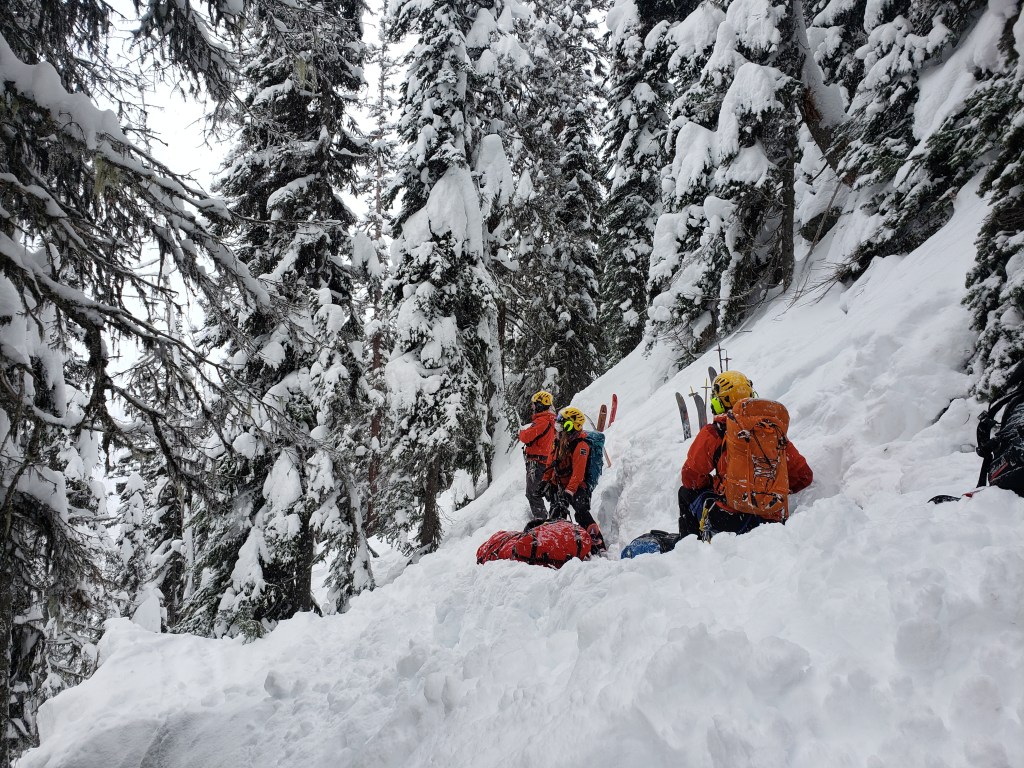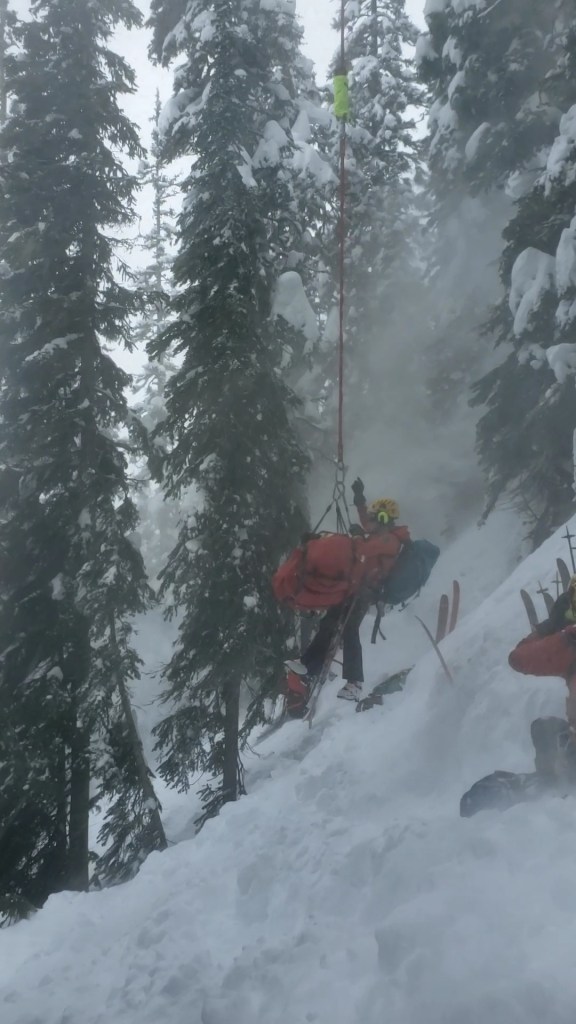Waiting on the skin track with Chet, we relished in the short but sweet run we’d just enjoyed. Blower powder, plenty of bumps and curvaceous spines to jump and spin off, and absolutely bottomless. We waited for 5 minutes, catching our breath. Then 10 minutes, now transitioning back to walk-mode. After 15 minutes I started to wonder, “Wasn’t the plan to meet at this lower skin track?”, “Could we have pushed too far skiers left?”. We were a group of 4, it was a pitch of roughly 600m, fairly steep and tightly treed. We decided to split into two groups of 2, you know, the buddy system. Keeping tabs on 1 is much easier than keeping tabs on 3.

Anyway, I figured I would check to see if my phone had any service. Low and behold, there was a couple bars of life. Instantly the phone came to life – a missed call, a voicemail, and a text message. Now, with the wild tech of 2020 my phone had visual voicemail, however, it’s not known for having the most accurate voice-to-text conversions. What I got read,
“T____, if you get this just give us a call back to me and she you just up the hill and we’re just waiting me possible broken leg”
My first thought was that my partner K____ had potentially broken her leg on the ski hill, 68km west of us in Revelstoke, BC. So, I quickly called back the number and heard a familiar voice say, “It’s Ryan, he’s broken his Tibia and thinks it might be a compound fracture… we’re four turns from where we split up”
An immediate rush of adrenaline and a flood of thoughts,
No way, this can’t happen to someone in our group
Four turns? Did he call out, surely we could have noticed?
Maybe it’s not broken… Just a bit of an overreaction
Now, I consider myself fairly adept on a skin track, I’ve got glide, I’ve got efficiency, I might even have some style with it. But the next 30 minutes contained none of that… Wildly we pushed ahead, blowing past a steady cadence and aerobic threshold, past the idea of not sweating through your base layers – it was all huff, puff, and chomp.

The day has started off grey, with the beautiful promise of a coming snowfall on the tip of the mountains tongue. But in this moment, that promise seemed daunting. Further we watched the ceiling fall and close in. We saw less and less of the surrounding mountain tops and the gentle falling of snow was like the first signs of fear, the first heightening of senses, the cautionary feeling entering your movements. Ryan had already called for a rescue (himself, almost immediately after sustaining his injury), but their plan was to come by helicopter… would this weather hold off? We started to contrive wild sled ideas….
Two skis strapped together… Yeah. And then we’ll sit him on the blade of his shovel… strap his two legs together. Someone will handle the toe of the skies, and someone will hold under his arms
Maybe you could just piggyback him Vince? We can create a sort of backpack with the triangular bandages!
But the more we climbed up into the terrain, the more we realized that moving him would be very difficult… and very painful.
As we neared the given altitude of 1750m we started to give a few hoots and hollers until we heard the call back from Julie. Luckily, she and Ryan had shared radios so he could quickly let her know something was wrong – and she could respond almost immediately. This response did involve her having to hike through pits deep snow for about 40m, but it was the quickest Ryan would get. We transitioned back into ride mode, took a breath, ensured we were both ready to go and descended to the sound of our friends.
We came down a steep treed area that had a just a couple tracks in it. We cautiously descended, being considerate not to push too much snow down, lest it rain down on our hurt friend. We finally came on scene. Ryan lay below a steep drop off created from a fallen tree, tucked in between about 3 other large spruce trees, and one cedar. It was a tight spot, and clearly one that he would have to be moved from. Luckily, about 10 meters from him was an small opening in the canopy, and having done Class-D long-line extraction myself, I knew this would be our golden ticket.
Now, I’m about 3 weeks from re-certifying my OFA-3, before that I had an Advanced Adventure Medic (80hours) First Aid, so I felt decently savvy. However, other members in our party had similar training, and we were an hour late to the party. When we arrived I was happy to find Ryan in a partially seated position, a thermal bivy underneath him and any layers from him or the team on top of him. It appeared another group of 2 happened to cruise past and stopped to assist. One member was searching for a suitable location for a long-line extraction and the other was helping to pack down the area.
Speaking honestly, if I had one regret about this experience it would be the nonchalant nature I conducted the next 20 minutes. Sure, we were not the first to arrive on scene, nor was I the only trained first-aider. But because he was my friend, and had clearly already been taken care of, I simply took a rough initial assessment, checked his pulse (74bpm) and did a rapid feel around the upper cuff of the boot on the leg he’d sustained the injury. I had felt that since a professional rescue team was imminent (the helicopter had done a reconnaissance a few minutes before) who would be equipped with the proper gear (vacuum splints etc.) that it’d be best to just keep him warm and comfortable and only provide an intervention if I deemed it life-threatening.

In hindsight, I think following the standard protocol would have benefited Ryan, since he knew someone was thoroughly looking after him, and myself, since I could be sure it was just a broken leg. Checking pulse, breathing rate, feeling the temp and moisture of his skin, asking some questions to ensure of no head injury, and a rapid body search to make sure there wasn’t any broken ribs, or internal bleeding being masked by the pain in his leg. During the assessment I might have noticed that a quasi-tourniquet (ski strap pulled tight-ish) had been applied to this upper thigh. A critical intervention that I would certainly have not advised. It would have provided Ryan with a point of focus away from his injury, and myself a piece of mind that I was giving my friend the best care possible.
We all made ourselves as useful as we could. Packing down the probable path of extraction, providing Ryan some warm tea, clearing more space around him for an easier packaging once the rescue team arrived.
The man himself was in remarkable standing. He joked about enjoying his first 4 turns, had a laugh, called the rescue in himself, and didn’t really complain about the fact that he was certainly cold from lying on top of snow for the better part of an hour with a broken leg. We made further contact with the Parks Visitor Safety Team and went through some Covid protocols.
Then we heard that familiar (for me) whop-whop-whop of the rotary-wing machine cutting through the air. First they dropped 1, then 2, then 1. Slowly, the rescue commenced. We stood back, providing the adequate space and undisturbed work for the Parks Canada Visitor Safety and ACS team. It’s truly a sight to watch them work. Very professional, equipped with top of the line gear, efficient, and dialed. The classic word I could describe the whole experience with would be, “cool”. It was just damn cool.

A rapid assessment, some Entonox, a vacuum splint, a vacuum mat, and a burrito bag and all he needed was a bit of chipotle mayo and he was ready to go. The call went out and in a few minutes the bright red Arrow B2 aircraft broke through the thickening clouds, and came in hovering just 30m above us. In an instant the trees let go of their snowy cocoons and they came thrashing down and call around us, I’m not sure how the Rescue team even managed to secure the hook, but we got he best faceshots we’d had all year! The 100’ long line was expertly placed in the hands of the visitor safety tech, she connected herself and her patient to the clevice, and was whisked up and away into the cloud-filled valley.

Our part was now over. The next steps were to get ourselves down safely and get the few soul turns in that we’d promised Ryan we would enjoy on his behalf.
Just like that hours had raced by, we had involved the help of 6 other people (2 friendly ski tourers, and 4 Parks Canada personnel), contracted a helicopter, reported to dispatch, and Ryan would very momentarily be travelling by ambulance to the Revelstoke hospital. It was smooth, efficient, and well executed. We even debriefed in the parking lot , ensuring we all had a chance to share some lessons learned, and how we were feeling and the whole ordeal.
Like most major incidents that aren’t in the original plans. You can’t believe it happened to you or your group. You realize the “what if” factor is truly important.
What if: The heli couldn’t have got him? We didn’t have any pain meds? No one had First Aid training? It was 3pm and we had to spend the night?
You can’t prepare for every outcome, but when you’re recreating in the backcountry you should make an attempt to prepare for most, because you never know when it could happen to you. It’s important to rely on the basic framework of the first aid skills and rescue techniques we learn, and apply them as best as you can. You’ll also typically have more time on your hands than you expected. Rescues take time to organize and implement, so take the time to properly wrap up your injured friend, to properly make them comfortable, and to assess your surroundings thoroughly. It was a learning experience for everyone, that went about as smoothly as it could have. I’d like to thank the professionals at Parks Canada for putting their lives at risk to help us out, and everyone else that played a part.
Remember, tread lightly and be prepared folks, it could happen to you!
Thank goodness you all handled this accident so well and are safe. I love hearing about your adventures. Love you, Nan
LikeLike
Thank you for sharing your story and what you learned!
It happened very similar to me end of October, very likely being the first rescue this season. You never think it’ll be one of you until it does. I hit a rock while going slowly and with caution, so my ski didn’t release and I broke my tibia as a spiral fracture and the fibular as a boot top. 2.5hrs from accident until the warmth of the ambulance in -15° as the helicopter rescue was quite difficult. We were good equipped, but I still learned a lot! Especially you can’t have enough warm clothes and first aid equipment, as if not in motion, you cool down so damn fast. Also I learned even with 6 layers (base, mid, puffy, gore Tex, thin puffy, thick puffy) plus 3 rescue blankets I still could feel my buddy’s body heat who helped me to stay warm. I never expected it to make such a difference, so cuddle up to help your injured friend even if you think it won’t be long until help arrives! My buddies were able to splint my leg (splint and ski straps) and created a safe spot next to me where later the helicopter bag was unfolded for me to crawl in). Time was a huge part in my rescue (getting close to the helicopter not flying anymore) and therefore it was a big plus we were preparing my flight out as much as we could. Also being in that rescue bag is part of survival, but everything than a comfortable way out. It was crazy cold in the helicopter bag and I realised I definitely had a naive way of thinking of an helicopter rescue being somehow comfortable. Don’t get me wrong, I was incredibly thankful to get out safely and all the pain and everything were nothing compared to what would have happened if we would have stayed out there for longer/overnight. I just realised each time I say ‘I got a flight out’, ppl react with “oh well, that must have been nice” and I would have said the same before I’ve been in it but I can honestly say these were probably the worst minutes of my life (pain in the leg that got moved around a lot during pick up, flight and lay down) while being extremely thankful for it at the same time. I still struggle with the (luckily) mild symptoms of frost bites on my toes (doctors were afraid I might loose them) and thanks to surgery I’m able to already slowly walk on my leg again and I might be even able to be back on skis late season. The Rescue team and my buddies did a fantastic job getting me out of the slope and I’m extremely thankful for their help! I’m calling myself lucky that they succeeded with a helicopter rescue instead of an overnighter – I would have very likely lost my toes in that case.
Let me know if you guys need anything, I am in Revelstoke and I have literally everything you need with a broken leg and am happy to pass on what I don’t need anymore.
I hope your buddy will heal fast!
LikeLike
So happy all ended well.
LikeLike